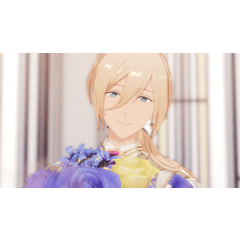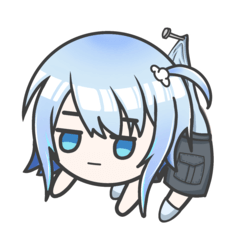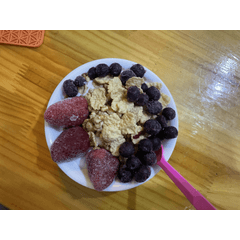エッジを交差させないために参照レイヤーを使用する消しゴムを平坦化する (ヒントについては、ページを参照) Flatting Eraser that uses a reference layer to avoid crossing edges (see page for tips)
CLIP STUDIO PAINT では、 参照レイヤーを使用してエッジを表示し、エッジの片側にのみペイントできます。これは基本的な機能です 。 [参照レイヤーの線を交差させない]を有効にし、いくつかの基本設定を行うだけで、誰でもブラシにこれを行うことができます。

Erase Along Edge は、エッジ検出機能付きの消しゴムで、図形の線が完全に閉じていない場合でも色をクリーンアップできます。
色を塗るよりも 、参照レイヤーを使った方が消 しやすく、楽しいのではないかと感じました。

この消しゴムは、私のガムロード/コーファイショップで見つけることができるタピオカデジタルペインティングブラシセットのフラットツールに含まれています。
参照レイヤーの設定を忘れずに!

- 線画レイヤーを選択します 。
- 灯台ボタンを押して、参照レイヤーとして設定します。
- 次に、カラーレイヤーを選択して、消去ツールを使用できます。 参照レイヤーを使用して、エッジがどこにあるかを判断します。
Brush size + Cross Cursor(ブラシサイズ+クロスカーソル)では、エッジがチェックされている場所を確認できます。


円の中心がどこにあるかを確認したい場合は、CLIP STUDIO PAINTの[環境設定]の[カーソル]>カーソルの形状]で カーソルの種類を変更できます。
「ブラシのサイズと十字」は、ブラシの半径を円で表示し、中央に小さな十字を表示します。これは、特にスクリーンレスタブレットを使用している場合に、エッジがチェックされている場所を確認するのに役立ちます。
----
追加情報
なぜ、いつ、この方法で消去する必要があるのですか?
オーバーフロー防止機能付きのブラシは、半径内にとどまるミニペイントバケツツールのように機能します。

ペイントにオーバーフロー 防止を使用すると、穴だらけの色になる可能性があります。内側の線が複雑になるほど 、この方法では問題が発生する可能性があります。

ブロブをペイントし、代わりに外側のエッジを消去すると、内側の穴を回避できます。形によっては、このように消しやすい場合もあります。

外側の交差する線もある場合でも、手動で消去する必要があります。これは、外側の線を処理する必要がある場合に使用するのに最適な消しゴムでさえないかもしれません。しかし、全体的なフラットのようなもの、特に最初の段階では、これは多くの時間を節約することができます。

これは、スケッチやラフアニメーションで、線が常に閉じているわけではないが、すばやく大まかに塗りつぶしたい場合に特に便利です。

適切なホットキーを使用すると、この消しゴムや他の消しゴムやフラット化ツールを簡単に切り替えて、さまざまなケースにすばやく適応できます。 この消しゴムは、着色レイヤーの小さなセクションをすばやく変更、編集、クリーンアップ する必要があるときに、頻繁に取り出すものです。


場合によっては、[囲んで塗りつぶす]のようなこのような場合に、より優れた高速 な塗りつぶし/平坦化ツールがあります。しかし、時には消しゴムが必要なものです。 さまざまなツールがあることを知っておくと、そのうちの 1 つが状況でうまく機能しない場合に備えて、より多くのオプションが得られます。

CLIP STUDIO PAINTのエッジ検出はアンチエイリアスされていないため、消去されたエッジは非常にギザギザになる可能性があります。これは、高解像度で作業する場合や、線が完全に不透明な場合は大きな問題ではありません。ただし、100%で作業する場合は、Filter>Blur>[Smoothing]またはわずかなガウスぼかしを適用して、粗さの一部を削除する必要がある場合があります。
---
このパートでは、Clip Studio Paintのエッジ検出がどのように機能するかを説明します
エッジ検出はどのように機能しますか?
このエッジ検出機能は、ほとんどのブラシで有効にできます。チェックボックスは、CSP 1.10 の [参照レイヤーの線を交差させない] というラベルが付けられています。このオプションが表示されない場合は、[サブツール詳細]ウィンドウで有効にする必要があります。


エッジ検出は、ブラシの半径に限定された ミニペイントバケツツールのように機能します。中心からエッジのチェックを開始し、エッジまたはブラシの半径が見つかった時点で停止し、そこでの効果を制限します。

エッジが円の半径内に完全に収まっていない場合、 ブラシの効果は エッジの反対側に 回り込みます。

エッジが透明または十分に明るい場合、ギャップとしてカウントされる場合があります 。この場合、ブラシの効果は、線が非常に薄かった隙間があるかのように、エッジの反対側を回ります。
このしきい値を変更するには、[色の余白]を調整します 。ゼロ(0)に設定する と、エッジの一部として最も明るい線でも停止します。

[エリアスケーリング]は 、設定したピクセル数だけエフェクトをエッジを超えて押し出します。これは、色が線や柔らかさ、質感 、またはアンチエイリアシングの下に収まるようにするのに役立ちます。1 または 2 で十分ですが、 場合によっては 5 または 10 が必要になることがあります。
3つの[スケーリングモード]は、ピクセルをどのように拡張するかを決定し、コーナーまたはテクスチャのいずれかで最も目立ちます。
- [矩形]は、角がボックスとして拡大します。
- [丸]は角が円状に広がります。
- [最も暗いピクセルまで]は、最大領域スケーリングで拡大しようとしますが、 ピクセルが最も暗い/最も不透明になったことを検出すると停止します。 これは、線やエッジの柔らかさや太さが可変である場合に便利ですが、 塗りつぶしが不完全に見えることもあります。

エッジがおかしい場合は、別の設定を試してみてください。
ご支援いただきありがとうございます!
あなたは私の店を訪れ て、他の 何百ものブラシを手に入れることができます!- @PharanBrush

Clip Studio Paint lets you use a reference layer to see edges and only paint on one side of the edge. This is a basic feature. Anyone can make any brush do this by just enabling [Do not cross lines of reference layer] and setting some basic settings.

Erase Along Edge is an eraser with edge detection [anti-overflow], for cleaning up colors even when the shape lines are not fully closed everywhere!
I felt that it might be both more controllable and more enjoyable to erase using a reference layer than color with it.

This eraser in included among my flatting tools in my Tapioca Digital Painting Brush Set you can find in my gumroad/ko-fi shop.
DON'T FORGET TO SET THE REFERENCE LAYER!

- Select the lineart layer.
- Press the lighthouse button to set it as a reference layer.
- Then you can select your color layer and use the erase tool. It will use the reference layer to judge where the edge is.
The Brush size + Cross Cursor lets you see where the edge is checked.


If you want to see where the center of the circle is, you can change the cursor type in Clip Studio Paint's [Preferences...] under Cursor>Shape of Cursor.
"Brush size and cross" will show the radius of the brush as a circle, and a small cross in the center. This helps you see where the edge is checked especially if you are using a screenless tablet.
----
Extra information
Why or when should I erase this way?
A brush with Anti-overflow works like a mini paint bucket tool that stays inside its radius.

If you use anti-overflow for painting, you can end up with colors that are full of holes. The more complicated the inner lines are, more this method might cause problems.

If you just paint a blob and then erase the outer edges instead, you avoid the inner holes. Depending on the shape, it can be easier to erase like this.

If there are also outer intersecting lines, you may still have to erase them manually. This may not even be the best eraser to use if outer lines need to be handled. But for things like overall flats, especially in the first stages, this can save a lot of time.

This is especially useful for sketches and rough animation, where your lines aren't always closed, but you still want to quickly and roughly give them a fill.

With the right hotkeys, you can easily switch between this and other erasers and flatting tools to quickly adapt to different cases. This eraser is something I pull out quite often when I just quickly need to change, edit and clean up small section of a coloring layer.


In some cases, there are better and faster fill/flatting tools for cases like this like [Enclose and Fill]. But sometimes, an eraser is what you need. Knowing you have different tools will give you more options in case one of them doesn't work well for a situation.

Clip Studio Paint's edge detection isn't antialiased so your erased edges can end up very jagged. This isn't a big problem if you work at high resolutions or your lines are fully opaque. But if you only work at 100%, you may need to apply Filter>Blur>[Smoothing] or a slight gaussian blur to remove some of the roughness.
---
This part just explains how Clip Studio Paint edge detection it works
How does its edge detection work?
You can enable this edge detection feature in most brushes. The checkbox is labeled [Do not cross lines of reference layer] in CSP 1.10. If you don't see this option, you may need to enable it in the [Sub Tool Detail] window.


The edge detection works like a mini paint bucket tool, confined to the radius of the brush. It starts checking for the edge from the center and stops when it sees an edge or the radius of the brush, then limits its effect there.

If the edge is not complete within the radius of the circle, the effect of the brush goes around to the other side of the edge.

Sometimes, if the edge is transparent or light enough, it will be counted as a gap. In this case, the effect of the brush will still go around the other side of the edge as if there is a gap where the line was very light.
To change this threshold, you can adjust [Color margin]. Set it to zero (0) if you want it to stop at even the lightest lines as part of the edge.

[Area scaling] pushes the effect past the edge by the number of pixels you set. This is useful so the color can go under the lines and any softness, texture or antialiasing that it has. 1 or 2 can be enough but in some cases, 5 or 10 may be required.
The three [Scaling modes] determine how it extends the pixels, which is most noticeable either on corners or textures.
- [Rectangle] expands at the corners as a box.
- [Round] expands at corners as a circle.
- [To darkest pixel] tries to expand by the maximum area scaling but still stops when it detects that the pixel has become its darkest/most opaque. This can be useful if the lines or edge has variable softness or thickness, but sometimes the fill can also look incomplete.

If the edges look wrong, try experimenting with different settings.
Thanks for your support!
You can visit my store for hundreds of other brushes! - @PharanBrush

















































